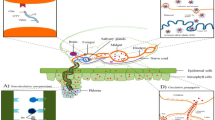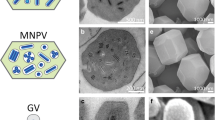Abstract
Pathogens face numerous challenges to persist in hosts with low or unpredictable population densities. Strategies include horizontal transmission, such as by the production of propagules that persist in the environment, and vertical transmission from adults to offspring. While many pathogens are capable of horizontal and vertical transmission little is known of their relative roles under realistic conditions of changing population densities. Insect baculoviruses can be transmitted both horizontally and vertically, although much of the work on baculovirus transmission has focussed on horizontal transmission that can be effective at high host densities. Here, we examine the prevalence of a vertically-transmitted, covert infection of nucleopolyhedrovirus (NPV) in field populations of the African armyworm, Spodoptera exempta, in Tanzania. African armyworm is a major pest of graminaceous crops in Africa and despite its migratory nature and boom and bust dynamics, NPV epizootics are common and can be intense at the end of the multi-generation armyworm season. We found that virtually all the insects collected in the field were positive for S. exempta NPV (SpexNPV) DNA and 60% of these insects had transcriptionally active virus. This suggests that SpexNPV is transmitted vertically at extremely high levels in field populations of S. exempta and can maintain a persistent infection without obvious symptoms. Similarly high levels of virus DNA and RNA were detected in a S. exempta colony that had been maintained in continuous culture for 5 years. This study provides an insight into mechanisms of pathogen persistence in migratory populations where hosts are unpredictable and indicates that covert infection may be more common and more relevant in disease dynamics of insects than had previously been thought.


Similar content being viewed by others
References
Bergold GH (1953) Insect viruses. Adv Virus Res 1:91–139. doi:10.1016/S0065-3527(08)60463-7
Bonsall MB, Sait SM, Hails RS (2005) Invasion and dynamics of covert infection strategies in stage-structured insect-pathogen populations. J Anim Ecol 74:464–474. doi:10.1111/j.1365-2656.2005.00991.x
Brown ES, Swaine G (1965) Virus disease of the African armyworm, Spodoptera exempta (Walker). Bull Entomol Res 56:671–684
Burden JP, Griffiths CM, Cory JS et al (2002) Vertical transmission of sublethal granulovirus infection in the Indian meal moth, Plodia interpunctella. Mol Ecol 11:547–555. doi:10.1046/j.0962-1083.2001.01439.x
Burden JP, Nixon CP, Hodgkinson AE et al (2003) Covert infections as a mechanism for long term persistence of baculoviruses. Ecol Lett 6:524–531. doi:10.1046/j.1461-0248.2003.00459.x
Chao Y-C, Lee S-T, Chang M-C et al (1992) Differential expression of Hz-1 baculovirus genes during productive and persistent infections. J Virol 63:1442–1448
Cheng C-H, Liu S-M, Chow T-Y et al (2002) Analysis of the complete genome sequence of the Hz-1 virus suggests that it is related to members of the Baculoviridae. J Virol 76:9024–9034. doi:10.1128/JVI.76.18.9024-9034.2002
Cooper D, Cory JS, Theilmann DA et al (2003) Nucleopolyhedroviruses of forest and western tent caterpillars: cross-infectivity and evidence for activation of latent virus in high density field populations. Ecol Entomol 28:41–50. doi:10.1046/j.1365-2311.2003.00474.x
Cory JS, Myers JH (2003) The ecology and evolution of insect baculoviruses. Annu Rev Ecol Evol Syst 34:239–272. doi:10.1146/annurev.ecolsys.34.011802.132402
Earn DJD, Rohani P, Grenfell BJ (1998) Persistence, chaos and synchrony in ecology and epidemiology. Proc R Soc Lond B Biol Sci 265:7–10. doi:10.1098/rspb.1998.0562
Federici BA (1997) Baculovirus pathogenesis. In: Miller LK (ed) The baculoviruses. Plenum Press, NY, pp 301–339
Funk CJ, Braunagel SC, Rohrmann GF (1997) Baculovirus structure. In: Miller LK (ed) The baculoviruses. Plenum Press, NY, pp 7–32
Fuxa JR, Sun J-Z, Weidner EH et al (1999) Stressors and rearing diseases of Trichoplusia ni: evidence of vertical transmission of NPV and CPV. J Invertebr Pathol 74:149–155. doi:10.1006/jipa.1999.4869
Herniou EA (2003) Use of comparative genomics and phylogenetics to study the evolution of the Baculoviridae. Imperial College, University of London, Unpublished Ph.D. thesis
Hughes DS, Possee RD, King LA (1993) Activation and detection of a latent baculovirus resembling Mamestra brassicae nuclear polyhedrosis virus in M. brassicae insects. Virology 194:604–615. doi:10.1006/viro.1993.1300
Hughes DS, Possee RD, King LA (1997) Evidence for the presence of a low-level, persistent baculovirus infection of Mamestra brassicae insects. J Gen Virol 78:1801–1805
Hunter FR, Crook NE, Entwistle PF (1984) Viruses are pathogens for the control of insects. In: Grainger JM, Lynch JM (eds) Microbiological methods for environmental biotechnology. Academic Press, NY, pp 323–347
IJkel WFJ, van Strien EA, Heldens JGM et al (1999) Sequence and organization of the Spodoptera exigua multicapsid nucleopolyhedrovirus genome. J Gen Virol 80:3289–3304
Jurkovicova M (1979) Activation of latent virus infections in larvae of Adoxophyes orana (Lepidoptera: Tortricidae) and Barathra brassicae (Lepidoptera: Noctuidae) by foreign polyhedra. J Invertebr Pathol 34:213–223. doi:10.1016/0022-2011(79)90066-1
Keeling MJ, Grenfell BT (1997) Disease extinction and community size: modelling the persistence of measles. Science 275:65–67. doi:10.1126/science.275.5296.65
Kelly DC, Lescott T, Ayres MD et al (1981) Induction of a non-occluded baculovirus persistently infecting Heliothis zea by Heliothis armigera and Trichoplusia ni nuclear polyhedrosis virus. Virology 112:174–180. doi:10.1016/0042-6822(81)90623-1
Kukan B (1999) Vertical transmission of nucleopolyhedrovirus in insects. J Invertebr Pathol 74:103–111. doi:10.1006/jipa.1999.4873
Lee J-C, Chao Y-C (1998) Apoptosis resulting from superinfection of Heliothis zea virus 1 is inhibited by p35 and is not required for virus interference. J Gen Virol 79:2293–2300
Lipsitch M, Nowak MA, Ebert D et al (1995) The population dynamics of vertically and horizontally transmitted parasites. Proc R Soc Lond B Biol Sci 260:321–327. doi:10.1098/rspb.1995.0099
Lipsitch M, Siller S, Nowak MA (1996) The evolution of virulence in pathogens with horizontal and vertical transmission. Evol Int J Org Evol 50:1729–1741. doi:10.2307/2410731
Lively CM, Clay K, Wade MJ et al (2005) Competitive co-existence of vertical and horizontally transmitted parasites. Evol Ecol Res 7:1183–1190
Longworth JF, Cunningham JC (1968) The activation of occult nuclear-polyhedrosis viruses by foreign nuclear polyhedra. J Invertebr Pathol 10:361–367. doi:10.1016/0022-2011(68)90094-3
Lu A, Miller LK (1995) The roles of eighteen baculovirus late expression factor genes in transcription and DNA replication. J Virol 69:475–482
Messenger SL, Molineaux IJ, Bull JJ (1999) Virulence evolution in a virus obeys a trade-off. Proc R Soc Lond B Biol Sci 266:397–404. doi:10.1098/rspb.1999.0651
Moore J (2002) Parasites and the behaviour of animals. Oxford University Press, Oxford
Myers JH, Malakar R, Cory JS (2000) Sublethal nucleopolyhedrovirus infection effects on female pupal weight, egg mass size and vertical transmission in gypsy moth (Lepidoptera; Lymantriidae). Environ Entomol 29:1268–1272
Pang Y, Yu JX, Wang LH et al (2001) Sequence analysis of the Spodoptera litura multicapsid nucleopolyhedrovirus genome. Virology 287:391–404. doi:10.1006/viro.2001.1056
Rose DJW, Dewhurst CF, Page WW (2000) The african armyworm handbook: the status, biology, ecology, epidemiology and management of Spodoptera exempta (Lepidoptera: Noctuidae), 2nd edn. Natural Resources Institute, Chatham
Rothman LD, Myers JH (1996) Debilitating effects of viral disease on host Lepidoptera. J Invertebr Pathol 67:1–10. doi:10.1006/jipa.1996.0001
Simón O, Williams T, Lopez-Ferber M, Caballero P (2004) Virus entry or the primary infection cycles are not the principal determinants of host specificity of Spodoptera spp. nucleopolyhedroviruses. J Gen Virol 85:2845–2855. doi:10.1099/vir.0.80179-0
Stewart AD, Logsdon JM, Kelley SE (2005) An empirical study of the evolution of virulence under both horizontal and vertical transmission. Evol Int J Org Evol 59:730–739
Stumpf MPH, Laidlaw Z, Jansen VAA (2002) Herpes viruses hedge their bets. Proc Natl Acad Sci USA 99:15234–15237. doi:10.1073/pnas.232546899
Swinton J, Harwood J, Grenfell BJ et al (1998) Persistence thresholds for phocine distemper virus infection in harbour seal Phoca vitulina metapopulations. J Anim Ecol 67:54–68. doi:10.1046/j.1365-2656.1998.00176.x
Titterington JS, Nun TK, Passarelli AL (2003) Functional dissection of the baculovirus late expression factor-8 gene: sequence requirements for late gene promoter activation. J Gen Virol 84:1817–1826. doi:10.1099/vir.0.19083-0
Turner PE, Cooper VS, Lenski RE (1998) Tradeoff between horizontal and vertical modes of transmission in bacterial plasmids. Evol Int J Org Evol 52:315–329. doi:10.2307/2411070
Vilaplana L, Redman EM, Wilson K et al (2008) Density-related variation in vertical transmission of a virus in the African armyworm. Oecologia 155:237–246. doi:10.1007/s00442-007-0914-9
Acknowledgments
We would like to thank Tim Carty for rearing the laboratory colony of S. exempta and for producing insect diet and John Burden for advice on PCR. We are also very grateful to Wilfred Mushobozi and colleagues in Arusha, Tanzania, for their input and support in the field and David Gryzwacz for his encouragement and support throughout the project. We would also like to thank David Grzywacz and Judy Myers for their comments on the manuscript and Hilary Lauzon for help with Fig. 2. This work was funded by NERC grant NER/A/S/2000/01141 to JSC and KW and partly funded by the United Kingdom Department for International Development (DFID) for the benefit of developing countries. The views expressed are not necessarily those of the DFID R7954 Crop Protection Research Programme. JSC would also like to acknowledge the support of the NSERC Canada Research Chair program.
Author information
Authors and Affiliations
Corresponding author
Rights and permissions
About this article
Cite this article
Vilaplana, L., Wilson, K., Redman, E.M. et al. Pathogen persistence in migratory insects: high levels of vertically-transmitted virus infection in field populations of the African armyworm. Evol Ecol 24, 147–160 (2010). https://doi.org/10.1007/s10682-009-9296-2
Received:
Accepted:
Published:
Issue Date:
DOI: https://doi.org/10.1007/s10682-009-9296-2




